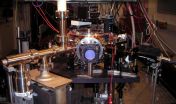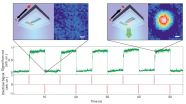(Press-News.org) Researchers from the University of Southampton have demonstrated for the first time a new laser cooling method, based upon the interference of matter waves, that could be used to cool molecules.
Our ability to produce samples of ultra-cold atoms has revolutionised experimental atomic physics, giving us devices from atomic clocks (the core of GPS) and enabling a range of quantum devices, including the possibility of a quantum computer.
However, the current technique of cooling atoms down from room temperature to the ultra-cold regime using optical molasses (the preferential scattering of laser photons from a particle in motion which leads to slowing) is limited to atoms with favourable electronic structure. As a result, only a small fraction of atomic elements, along with a select few diatomic molecules, have been cooled in this manner.
Writing in Physical Review Letters, the research team at Southampton has provided the first proof-of-principle demonstration of a new laser cooling technique, based on a proposal by Martin Weitz and Nobel laureate Ted Hänsch in 2000, which is in principle applicable to atoms and molecules as yet untamed by conventional laser cooling.
Using the new approach, which harnesses the quantum interference of matter waves, the team was able to cool a sample of already-cold Rubidium down close to the fundamental temperature limit of laser cooling.
The cooling technique is based on matter wave interferometry, in which an atom (the matter wave) is placed into a superposition of states by a laser pulse. The atom travels simultaneously along two paths, which interfere at a later time, and the impulse imparted to the atom depends on the difference between these paths. The same phenomenon can be used to engineer an extremely sensitive metrological device.
Fundamentally, the impulse depends upon how the difference in energy along the two paths compares with the energy of the laser photons, where the atom's energy is formed of potential (internal electron configuration) and kinetic (external motion) parts.
The clever trick behind Weitz and Hänsch's scheme is to make the laser interact with the atoms in such a manner as to remove the dependence on the potential energy, and thus the internal electronic structure, leaving the interference based solely on the kinetic energy of the particle.
The team at Southampton has demonstrated the principle of using matter wave interference to cool atoms. Their results are a significant step toward decoupling the cooling mechanism from the internal electronic structure - the 'Holy Grail' of general molecular laser cooling.
Dr Alex Dunning, from Physics and Astronomy at the University of Southampton and lead author of the study, said: "There is a great push to extend ultra-cold physics to the rest of the periodic table to explore a greater wealth of fundamental processes and develop new technologies and we hope that our demonstration will help.
"While other cooling techniques can be effective they are limited to certain species and often require a multitude of lasers. Our technique, should we succeed in extending it to Weitz and Hänsch's complete scheme, would be sort of a catch-all; progress so far in cooling molecules tends to use the details of specific molecules, rather than being something general; that's why this is exciting, even though our actual experiment just uses atoms."
Group leader, Dr Tim Freegarde, said: "These beautiful results have demonstrated that the method is feasible and can result in colder atoms than conventional Doppler cooling. To move on to other atoms and molecules will require more powerful lasers with shorter pulses, of the type used in coherent control chemistry, so the future of this method is very promising."
INFORMATION:
Methylmercury, a toxic form of mercury that is readily absorbed from the gastro-intestinal tract and can cause in a variety of health issues, poses a significant threat to marine animals at the top of the food web. A new study confirms that Artic species of these animals have higher concentrations of methylmercury in their tissues compared with animals lower in the food web; however, it also shows similar trends in selenium, which could help play a protective role against the toxic effects of mercury.
"Methylmercury concentrations increased through the food web at greater ...
When a patient is in urgent need of a doctor for illness or injury, expecting that doctor to help is natural.
But a new study , published in Social Psychological and Personality Science, finds that the greater patients' need for medical care, the more likely patients will view their doctors as "empty vessels," devoid of emotions or personal lives of their own; at the same time, those patients expect their physicians to be able to contain the patients' emotions and experiences.
The study is unusual in that most research focuses on the reverse--how physicians view patients.
In ...
Students who have used electronic cigarettes by the time they start ninth grade are more likely than others to start smoking traditional cigarettes and other combustible tobacco products within the next year, according to a new study funded by the National Institutes of Health. E-cigarettes deliver nicotine to the lungs by heating a liquid solution that contains nicotine and other chemicals to produce an aerosol that the user inhales, a process often called "vaping."
The study compared tobacco use initiation among 222 students who had used e-cigarettes, but not combustible ...
August 18, 2015--Individuals near the middle of the social hierarchy suffer higher rates of depression and anxiety than those at the top or bottom, according to researchers at Columbia University's Mailman School of Public Health. Nearly twice the number of supervisors and managers reported they suffered from anxiety compared to workers. Symptoms of depression were reported by 18 percent of supervisors and managers compared to 12 percent for workers. Findings are online in the journal Sociology of Health & Illness.
While social disadvantage related to income and educational ...
A new study indicates that for a 2.5 year period shortly before and during the early years of the Greek economic crisis, the prevalence of overweight and obesity decreased in Greek schoolchildren. This was accompanied by an increase in the prevalence of normal weight children and a slight increase in the prevalence of underweight children.
Because this study coincided with the eruption of the Greek economic crisis, it suggests that the changes may be related to the suboptimal conditions that a significant percentage of the Greek population lived in during that period.
Additional ...
CHAPEL HILL NC - Although metformin was introduced as a treatment for type 2 diabetes nearly 60 years ago and is now the recommended first-line treatment for newly diagnosed patients, researchers still debate precisely how the drug works. Now, a study published online today in Diabetes Care by researchers at the University of North Carolina School of Medicine, Elcelyx Therapeutics, and other leading endocrinologists provides strong evidence that metformin's primary effect occurs in the gut, not the bloodstream. The paper outlines results from phase 1 and phase 2 studies ...
Research suggests intoxicated victims of sexual assault could accurately retain information from events
Findings are being applied to develop National Guidelines for how the police could interview sexual assault victims who were intoxicated during the crime
Challenges misconception that intoxicated victims and witnesses are unreliable
People are often concerned about the accuracy of testimony given by victims who were intoxicated during a sexual assault- but a new study by University of Leicester researchers has found that while alcohol intoxicated participants ...
Long considered in relation to malnutrition and humanitarian aid, food security policy should be moving towards a much broader landscape and focusing on regular access to food for a population nearing nine billion towards 2030-2050, while addressing food insecurity for a fraction of communities, according to a JRC foresight report.
Due to a growing population, climate change, limiting expansion of agricultural land and increasing demand of high-energy food input, achieving global food security will be one of the most critical challenges in the coming years. Traditionally ...
This news release is available in German.
Microbes are the oldest and most successful organisms on the planet, and they communicate and interact using chemistry as their language. While research of the past decades has uncovered fascinating insights into the chemical interactions of microorganisms in the laboratory, it remains extremely challenging to understand what happens in the natural environment. One of the key issues is the difficulty to tie the production of particular molecules to individual bacterial cells or at least populations of cells in complex environmental ...
For the first time ever, researchers have succeeded in creating arrangements of colloids - tiny particles suspended in a solution - and, importantly, they have managed to control their motion with high precision and speed. Thanks to this new technique developed by scientists at the University of Zurich, colloidal nanoparticles may play a role in digital technologies of the future. Nanoparticles can be rapidly displaced, require little energy and their small footprint offers large storage capacity - all these attributes make them well suited to new data storage applications ...



